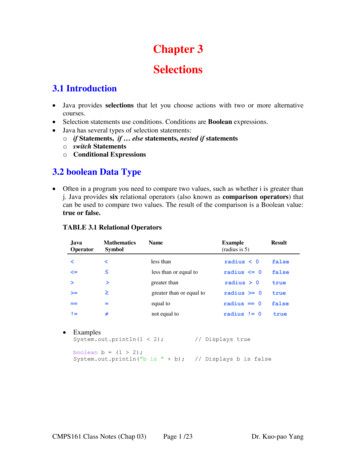
Transcription
Chapter 3Selections3.1 Introduction Java provides selections that let you choose actions with two or more alternativecourses.Selection statements use conditions. Conditions are Boolean expressions.Java has several types of selection statements:o if Statements, if else statements, nested if statementso switch Statementso Conditional Expressions3.2 boolean Data Type Often in a program you need to compare two values, such as whether i is greater thanj. Java provides six relational operators (also known as comparison operators) thatcan be used to compare two values. The result of the comparison is a Boolean value:true or false.TABLE 3.1 Relational Operators JavaOperatorMathematicsSymbolNameExample(radius is 5)Result less thanradius 0false less than or equal toradius 0false greater thanradius 0true greater than or equal toradius 0true equal toradius 0false! not equal toradius ! 0trueExamplesSystem.out.println(1 2);// Displays trueboolean b (1 2);System.out.println("b is " b);// Displays b is falseCMPS161 Class Notes (Chap 03)Page 1 /23Dr. Kuo-pao Yang
Problem: A Simple Math Learning Tool This example creates a program to let a first grader practice additions. The programrandomly generates two single-digit integers number1 and number2 and displays aquestion such as “What is 7 9?” to the student. After the student types the answer,the program displays a message to indicate whether the answer is true or false.LISTINT 3.1 AdditionQuiz.javaimport java.util.Scanner;public class AdditionQuiz {public static void main(String[] args) {int number1 (int)(System.currentTimeMillis() % 10);int number2 (int)(System.currentTimeMillis() / 7 % 10);// Create a ScannerScanner input new Scanner(System.in);System.out.print("What is " number1 " " number2 "? ");int answer input.nextInt();System.out.println(number1 " " number2 " " answer " is " (number1 number2 answer));}}What is 1 7? 81 7 8 is trueWhat is 4 8? 94 8 9 is falseCMPS161 Class Notes (Chap 03)Page 2 /23Dr. Kuo-pao Yang
3.3 if Statementsif (booleanExpression) {statement(s);}// execution flow chart is shown in Figure (A)Exampleif (radius 0) {area radius * radius * PI;System.out.println("The area for the circle of radius " radius " is " area);} // if the Boolean expression evaluates to true, the statements inthe block are executedFIGURE 3.1 An if statement executes statements if the Boolean Expression evaluates astrue Note:o The Boolean expression is enclosed in parentheses for all forms of the ifstatement. Thus, the outer parentheses in the previous if statements are required.if i 0 {System.out.println("i is positive");}if (i 0) {System.out.println("i is positive");}(a) Wrong(b) Correcto The braces can be omitted if they enclose a single statement.if (i 0) {System.out.println("i is positive");}Equivalent(b)(a)CMPS161 Class Notes (Chap 03)if (i 0)System.out.println("i is positive");Page 3 /23Dr. Kuo-pao Yang
Write a program that prompts the user to enter an integer. If the number is a multipleof 5, print HiFive. If the number is divisible by 2, print HiEven.LISTING 3.2 SimpleIfDemo.javaimport java.util.Scanner;public class SimpleIfDemo {public static void main(String[] args) {Scanner input new Scanner(System.in);System.out.println("Enter an integer: ");int number input.nextInt();if (number % 5 0)System.out.println("HiFive");if (number % 2 0)System.out.println("HiEven");}}Enter an integer: 4HiEvenEnter an integer: 30HiFiveHiEvenCMPS161 Class Notes (Chap 03)Page 4 /23Dr. Kuo-pao Yang
3.4 Two-Way if-else Statementsif (booleanExpression) {statement(s)-for-the-true-case;}else {statement(s)-for-the-false-case;}FIGURE 3.2 An if-else statement executes statements for the true case if the Booleanexpression evaluations are true; otherwise, statements for the false case are executed. if.else Exampleif (radius 0) {area radius * radius * PI;System.out.println("The area for the circle of radius " radius " is " area);}else {System.out.println("Negative input"); // braces may be omitted}Note: If radius 0 is true, area is computed and displayed; if it is false, the message“Negative input” is printed. Using the if else statement, you can rewrite the following code for determiningwhether a number is even or odd, as follows:if (number % 2 0)System.out.println(number “ is even.”);if (number % 2 ! 0)System.out.println(number “is odd.”);// rewriting the code using elseif (number % 2 0)System.out.println(number “ is even.”);elseSystem.out.println(number “is odd.”);Note: This is more efficient because whether number % 2CMPS161 Class Notes (Chap 03)Page 5 /23is 0 is tested only once.Dr. Kuo-pao Yang
3.5 Nested if and Multi-Way if-else Statements The statement in an if or if . else statement can be any legal Java statement,including another if or if . else statement. The inner if statement is said to be nestedinside the outer if statement.The inner if statement can contain another if statement.There is no limit to the depth of the nesting.if (i k) {if (j k)System.out.println(“i and j are greater than k”);}elseSystem.out.println(“i is less than or equal to k”);// the if (j k) is nested inside the if (i k) The nested if-else statement can be used to implement multiple alternatives.if (score 90.0)System.out.print("A");elseif (score 80.0)System.out.print("B");elseif (score 70.0)System.out.print("C");elseif (score ");EquivalentThis is better(a)if (score 90.0)System.out.print("A");else if (score 80.0)System.out.print("B");else if (score 70.0)System.out.print("C");else if (score ");(b)FIGURE 3.3 A preferred format for multiple alternatives is shown in (b) using a multiway if-else statement.FIGURE 3.4 You can use a multi-way if-else statement to assign a grade.CMPS161 Class Notes (Chap 03)Page 6 /23Dr. Kuo-pao Yang
3.6 Common Errors and Pitfalls Common Error 1: Forgetting Necessary Bracesif (radius 0)area radius * radius * PI;System.out.println("The area " " is " area);if (radius 0){area radius * radius * PI;System.out.println("The area " " is " area);}(a) Wrong (b) CorrectCommon Error 2: Wrong Semicolon at the if Lineo Adding a semicolon at the end of an if clause is a common mistake.o This mistake is hard to find, because it is not a compilation error or a runtimeerror, it is a logic error.o This error often occurs when you use the next-line block style.if (radius 0) ;{area radius * radius * PI;System.out.println("The area " " is " area);}Equivalent if (radius 0) { } ;{area radius * radius * PI;System.out.println("The area " " is " area);}(b)(a) Common Error 3: Redundant Testing of Boolean Valueso To test whether a Boolean variable is true or false in a test condition, it isredundant to use the equality comparison operator like this:if (even true)System.out.println("It is even.");Equivalentif (even)System.out.println("It is even.");(b)(a)Cautiono What’s wrong with the following?if (even true)System.out.println(“It is even.”);This statement does not have syntax errors. It assigns true to even so that even isalways true.CMPS161 Class Notes (Chap 03)Page 7 /23Dr. Kuo-pao Yang
Common Error 4: Dangling else Ambiguityo The else clause matches the most recent unmatched if clause in the same block.For example, the following statement:int i 1; int j 2; int k 3;if (i j)if (i B");is equivalent to:int i 1; int j 2; int k 3;if (i j)if (i B");o Nothing is printed from the preceding statement because the compiler ignoresindentation. To force the else clause to match the first if clause, you must add apair of braces:int i 1; int j 2; int k 3;if (i j) {if (i "B");This statement prints B. Common Error 5: Equality Test of Two Floating-Point Valueso You expect the following code to display true, but surprisingly it displays false.double x 1.0 - 0.1 - 0.1 - 0.1 - 0.1 - 0.1;System.out.println(x 0.5);Here, x is not exactly 0.5, but is 0.5000000000000001.CMPS161 Class Notes (Chap 03)Page 8 /23Dr. Kuo-pao Yang
Common Pitfall 1: Simplifying Boolean Variable Assignmento Often new Programmers write that assigns a test condition to a Boolean variablelike the code in (a).if (number % 2 0)even true;elseeven false;Equivalentboolean even number % 2 0;(b)(a)o The code can be simplified by assigning the test value directly to the variable, asshown in (b). This is not an error, but it should be better written as shown in (b). Common Pitfall 2: Avoiding Duplicate Code in Different Caseso Often, new programmers write the duplicate code in different cases that should becombined in one place. For example, the highlighted code in the followingstatement is duplicated.if (inState) {tuition 5000;System.out.println("The tuition is " tuition);}else {tuition 15000;System.out.println("The tuition is " tuition);}This is not an error, but it should be better written asfollows:if (inState) {tuition 5000;}else {tuition 15000;}System.out.println("The tuition is " tuition);o The new code removes the duplication and makes the code easy to maintain,because you only need to change in one place if the print statement is modified.CMPS161 Class Notes (Chap 03)Page 9 /23Dr. Kuo-pao Yang
3.7 Generating Random Numbers This example creates a program to teach a first grade child how to learn subtractions.The program randomly generates two single-digit integers number1 and number2with number1 number2 and displays a question such as “What is 9 – 2?” to thestudent, as shown in the figure. After the student types the answer in the input dialogbox, the program displays a message dialog box to indicate whether the answer iscorrect.LISTING 3.3 SubtractionQuiz.javaimport java.util.Scanner;public class SubtractionQuiz {public static void main(String[] args) {// 1. Generate two random single-digit integersint number1 (int)(Math.random() * 10);int number2 (int)(Math.random() * 10);// 2. If number1 number2, swap number1 with number2if (number1 number2) {int temp number1;number1 number2;number2 temp;}// 3. Prompt the student to answer “what is number1 – number2?”System.out.print("What is " number1 " - " number2 "? ");Scanner input new Scanner(System.in);int answer input.nextInt();// 4. Grade the answer and display the resultif (number1 - number2 answer)System.out.println("You are correct!");elseSystem.out.println("Your answer is wrong.\n" number1 " - " number2 " should be " (number1 - number2));}}What is 6 - 6? 0You are correct!What is 9 - 2? 5Your answer is wrong.9 - 2 should be 7CMPS161 Class Notes (Chap 03)Page 10 /23Dr. Kuo-pao Yang
3.8 Case Study: Computing Body Mass Index Body Mass Index (BMI) is a measure of health on weight. It can be calculated bytaking your weight in kilograms and dividing by the square of your height in meters.The interpretation of BMI for people 16 years or older is as follows:BMIInterpretationBMI 18.518.5 BMI 25.025.0 BMI 30.030.0 BMIUnderweightNormalOverweightObeseLISTING 3.4 ComputeAndInterpretBMI.javaimport java.util.Scanner;public class ComputeAndInterpretBMI {public static void main(String[] args) {Scanner input new Scanner(System.in);// Prompt the user to enter weight in poundsSystem.out.print("Enter weight in pounds: ");double weight input.nextDouble();// Prompt the user to enter height in inchesSystem.out.print("Enter height in inches: ");double height input.nextDouble();final double KILOGRAMS PER POUND 0.45359237; // Constantfinal double METERS PER INCH 0.0254; // Constant// Compute BMIdouble weightInKilograms weight * KILOGRAMS PER POUND;double heightInMeters height * METERS PER INCH;double bmi weightInKilograms /(heightInMeters * heightInMeters);// Display resultSystem.out.println("BMI is " bmi);if (bmi 18.5)System.out.println("Underweight");else if (bmi 25)System.out.println("Normal");else if (bmi .println("Obese");}}Enter weight in pounds: 146Enter height in inches: 70BMI is 20.948603801493316NormalCMPS161 Class Notes (Chap 03)Page 11 /23Dr. Kuo-pao Yang
3.9 Case Study: Computing Taxes The US federal personal income tax is calculated based on the filing status andtaxable income. There are four filing statuses: single filers, married filing jointly,married filing separately, and head of household. The tax rates for 2009 are shownbelow.TABLE 3.2 2009 U.S. Federal Personal Tax Rates LISTING 3.5 ComputeAndInterpretBMI.javaimport java.util.Scanner;public class ComputeTax {public static void main(String[] args) {// Create a ScannerScanner input new Scanner(System.in);// Prompt the user to enter filing statusSystem.out.print("(0-single filer, 1-married jointly or " "qualifying widow(er), 2-married separately, 3-head of " "household) Enter the filing status: ");int status input.nextInt();// Prompt the user to enter taxable incomeSystem.out.print("Enter the taxable income: ");double income input.nextDouble();// Compute taxdouble tax 0;if (status 0) { // Compute tax for single filersif (income 8350)tax income * 0.10;else if (income 33950)tax 8350 * 0.10 (income - 8350) * 0.15;else if (income 82250)tax 8350 * 0.10 (33950 - 8350) * 0.15 (income - 33950) * 0.25;else if (income 171550)tax 8350 * 0.10 (33950 - 8350) * 0.15 (82250 - 33950) * 0.25 (income - 82250) * 0.28;else if (income 372950)CMPS161 Class Notes (Chap 03)Page 12 /23Dr. Kuo-pao Yang
tax 8350 * 0.10 (82250 - 33950) *(income - 171550)elsetax 8350 * 0.10 (82250 - 33950) *(372950 - 171550)(33950 - 8350) * 0.15 0.25 (171550 - 82250) * 0.28 * 0.33;(33950 - 8350) * 0.15 0.25 (171550 - 82250) * 0.28 * 0.33 (income - 372950) * 0.35;}else if (status 1) { // Compute tax for married file jointly// Left as exercise}else if (status 2) { // Compute tax for married separately// Left as exercise}else if (status 3) { // Compute tax for head of household// Left as exercise}else {System.out.println("Error: invalid status");System.exit(1);}// Display the resultSystem.out.println("Tax is " (int)(tax * 100) / 100.0);}}(0-single filer, 1-married jointly or qualifying widow(er), 2married separately, 3-head of household) Enter the filing status: 0Enter the taxable income: 40000Tax is 6187.5CMPS161 Class Notes (Chap 03)Page 13 /23Dr. Kuo-pao Yang
3.10 Logical Operators Logical operators, also known as Boolean operators, operate on Boolean values tocreate a new Boolean value.TABLE 3.3 Boolean OperatorsOperator NameDescription!notlogical negation&&andlogical conjunction orlogical disjunction exclusive orlogical exclusionExamples&& (and) (or)! (not)(1 x) && (x 100)(lightsOn) (isDayTime)!(isStopped)TABLE 3.4 Truth Table for Operator !p!pExample (assume age 24, weight 140)truefalsefalsetrue!(age 18) is false,because (age 18) is true.!(weight 150) is true,because (weight 150) is false.TABLE 3.5 Truth Table for Operator &&p1p2p1 && p2Example (assume age 24, weight 140)falsefalsefalse(age 18) && (weight 140) is false,because (age 18) and (weight 140) are both false.falsetruefalsetruefalsefalsetruetruetrue(age 18) && (weight 140) is false,because (weight 140) is false.(age 18) && (weight 140) is true,because both (age 18) and (weight 140) are true.TABLE 3.6 Truth Table for Operator p1p2p1 etrueExample (assume age 24, weight 140)(age 34) (weight 140) is true,because (age 34) is false, but (weight 140) is true.(age 14) (weight 150) is false,because (age 14) is true.CMPS161 Class Notes (Chap 03)Page 14 /23Dr. Kuo-pao Yang
TABLE 3.7 Truth Table for Operator p1p2p1 efalseExample (assume age 24, weight 140)(age 34) (weight 140) is true,because (age 34) is false and (weight 140) is false.(age 34) (weight 140) is true,because (age 34) is false but (weight 140) is true.(age 14) (weight 140) is true,because (age 14) is true and (weight 140) is false.LISTING 3.6 TestBooleanOperators.javaimport java.util.Scanner;public class TestBooleanOperators {public static void main(String[] args) {// Create a ScannerScanner input new Scanner(System.in);// Receive an inputSystem.out.print("Enter an integer: ");int number input.nextInt();if (number % 2 0 && number % 3 0)System.out.println(number " is divisible by 2 and 3.");if (number % 2 0 number % 3 0)System.out.println(number " is divisible by 2 or 3.");if (number % 2 0 number % 3 0)System.out.println(number " divisible by 2 or 3, but not both.");}}Enter an integer: 44 is divisible by 2 or 3.4 divisible by 2 or 3, but not both.Enter an integer: 1818 is divisible by 2 and 3.18 is divisible by 2 or 3.CMPS161 Class Notes (Chap 03)Page 15 /23Dr. Kuo-pao Yang
3.11 Case Study: Determining Leap Year This program first prompts the user to enter a year as an int value and checks if it is aleap year.A year is a leap year if it is divisible by 4 but not by 100, or it is divisible by 400.(year % 4 0 && year % 100 ! 0) (year % 400 0) LISTING 3.7 LeapYear.javaimport java.util.Scanner;public class LeapYear {public static void main(String args[]) {// Create a ScannerScanner input new Scanner(System.in);System.out.print("Enter a year: ");int year input.nextInt();// Check if the year is a leap yearboolean isLeapYear (year % 4 0 && year % 100 ! 0) (year % 400 0);// Display the result in a message dialog boxSystem.out.println(year " is a leap year? " isLeapYear);}}Enter a year: 20082008 is a leap year? trueEnter a year: 19002002 is a leap year? falseCMPS161 Class Notes (Chap 03)Page 16 /23Dr. Kuo-pao Yang
3.12 Case Study: Lottery Write a program that randomly generates a lottery of a two-digit number, prompts theuser to enter a two-digit number, and determines whether the user wins according tothe following rule:o If the user input matches the lottery in exact order, the award is 10,000.o If the user input match all the digits in the lottery, the award is 3,000.o If one digit in the user input matches a digit in the lottery, the award is 1,000. LISTING 3.8 Lottery.javaimport java.util.Scanner;public class Lottery {public static void main(String[] args) {// Generate a lotteryint lottery (int)(Math.random() * 100);// Prompt the user to enter a guessScanner input new Scanner(System.in);System.out.print("Enter your lottery pick (two digits): ");int guess input.nextInt();// Get digits from lotteryint lotteryDigit1 lottery / 10;int lotteryDigit2 lottery % 10;// Get digits from guessint guessDigit1 guess / 10;int guessDigit2 guess % 10;System.out.println("The lottery number is " lottery);// Check the guessif (guess lottery)System.out.println("Exact match: you win 10,000");else if (guessDigit2 lotteryDigit1&& guessDigit1 lotteryDigit2)System.out.println("Match all digits: you win 3,000");else if (guessDigit1 lotteryDigit1 guessDigit1 lotteryDigit2 guessDigit2 lotteryDigit1 guessDigit2 lotteryDigit2)System.out.println("Match one digit: you win 1,000");elseSystem.out.println("Sorry, no match");}}Enter your lottery pick (two digits): 45The lottery number is 12Sorry, no matchEnter your lottery pick (two digits): 23The lottery number is 34Match one digit: you win 1,000CMPS161 Class Notes (Chap 03)Page 17 /23Dr. Kuo-pao Yang
3.13 switch Statements One can write a switch statement to replace a nested if statement. For example,switch (status) {case 0: compute taxes for single filers;break;case 1: compute taxes for married file jointly;break;case 2: compute taxes for married file separately;break;case 3: compute taxes for head of household;break;default: System.out.println("Errors: invalid status");System.exit(0);} // checks if status matches the values 0, 1, 2, or 3 respectively.FIGURE 3.5 The switch statement checks all cases and executes the statement inmatched casesThe switch Statement Rules: The switch-expression must yield a value of char, byte, short, or int type and mustalways be enclosed in parentheses. The value1. and valueN must have the same data type as the value of the switchexpression. value1. and valueN are constant expressions, meaning that they cannotcontain variables in the expression, such as 1 x. When the value in a case statement matches the value of the switch-expression, thestatements starting from this case are executed until either a break statement or theend of the switch statement is reached.CMPS161 Class Notes (Chap 03)Page 18 /23Dr. Kuo-pao Yang
The keyword break is optional. The break statement immediately ends the switchstatement.The default case, which is optional, can be used to perform actions when none ofthe specified cases matches the switch-expression.The cases statements are checked in sequential order, but the order of the cases(including the default case) does not matter. However, it is a good programming styleto follow the logical sequence of the cases and place the default case at the end.Caution Do not forget to use a break statement when one is needed. Once a case is matched,the statements starting from the matched case are executed until a break statement orthe end of the switch statement is reached. This is referred to as fall-through behavior.For example, the following code displays Weekdays for day of 1 to 5 and Weekendsfor day 0 and 6.switch (day) {case 1:case 2:case 3:case 4:case 5: System.out.println("Weekday"); break;case 0:case 6: System.out.println("Weekend");}CMPS161 Class Notes (Chap 03)Page 19 /23Dr. Kuo-pao Yang
Problem (Chinese Zodiac): Write a program that prompts the user to enter a year anddisplays the animal for the year.FIGURE 3.6 The Chinese Zodiac is based on a twelve-year cycle LISTING 3.9 ChineseZodiac.javaimport java.util.Scanner;public class ChineseZodiac {public static void main(String[] args) {Scanner input new Scanner(System.in);System.out.print("Enter a year: ");int year input.nextInt();switch (year % 12) {case 0: System.out.println("monkey"); break;case 1: System.out.println("rooster"); break;case 2: System.out.println("dog"); break;case 3: System.out.println("pig"); break;case 4: System.out.println("rat"); break;case 5: System.out.println("ox"); break;case 6: System.out.println("tiger"); break;case 7: System.out.println("rabbit"); break;case 8: System.out.println("dragon"); break;case 9: System.out.println("snake"); break;case 10: System.out.println("horse"); break;case 11: System.out.println("sheep"); break;}}Enter a year: 1963}rabbitEnter a year: 2014horseCMPS161 Class Notes (Chap 03)Page 20 /23Dr. Kuo-pao Yang
3.14 Conditional Expressions Conditional expressions are in different style, which no explicit if in the statement.The syntax is shown below:BooleanExpression ? exprssion1 : exprssion2; The result of this conditional expression expression1 if BooleanExpression is true;otherwise the result is expression2.For example:if (x 0)y 1elsey -1;is equivalent toy (x 0) ? 1 : -1; For example:if (num % 2 0)System.out.println(num "is even");elseSystem.out.println(num "is odd");is equivalent toSystem.out.println((num % 2 0)? num "is even" : num "isodd"); For example:Max (num1 num2)? num1 : num2;Note The symbols ? and : appear together in a conditional expression. They form acondition operator. The operator is called a ternary operator because it uses threeoperands.CMPS161 Class Notes (Chap 03)Page 21 /23Dr. Kuo-pao Yang
3.15 Operator Precedence and AssociativityHow to evaluate?3 4 * 4 5 * (4 3) - 1 The precedence rule defines precedence for operators as shown below.If operators with the same precedence are next to each other, their associativitydetermines the order of evaluation.All binary operators except assignment operators are left-associative. For example:a – b c – d is equivalent to ((a – b) c) – dAssignment operators are right-associative. Therefore, the expressiona b c 5 is equivalent to a (b (c 5))TABLE 3.8 Operator Precedence Chartvar , var- , - (Unary plus and minus), var,--var(type) Casting! (Not)*, /, % (Multiplication, division, and modulus) , - (Binary addition and subtraction) , , , (Comparison) ,! (Equality)& (Unconditional AND) (Exclusive OR) (Unconditional OR)&& (Conditional AND) Short-circuit AND (Conditional OR) Short-circuit OR , , - , * , / , % (Assignment operator) ExampleApplying the operator precedence and associativity rule, the expression 3 4 * 4 5* (4 3) - 1 is evaluated as follows:3 4 * 4 5 * (4 3) - 13 4 * 4 5 * 7 – 13 16 5 * 7 – 1(1) inside parentheses first(2) multiplication(3) multiplication3 16 35 – 119 35 – 119 34falseCMPS161 Class Notes (Chap 03)(4) addition(5) subtraction(6) greater thanPage 22 /23Dr. Kuo-pao Yang
3.16 Debugging Logic errors are called bugs. The process of finding and correcting errors is calleddebugging. A common approach to debugging is to use a combination of methods tonarrow down to the part of the program where the bug is located. You can hand-tracethe program (i.e., catch errors by reading the program), or you can insert printstatements in order to show the values of the variables or the execution flow of theprogram. This approach might work for a short, simple program. But for a large,complex program, the most effective approach for debugging is to use a debuggerutility.Debugger is a program that facilitates debugging. You can use a debugger too Execute a single statement at a time.o Trace into or stepping over a method.o Set breakpoints.o Display variables.o Display call stack.o Modify variables.CMPS161 Class Notes (Chap 03)Page 23 /23Dr. Kuo-pao Yang
CMPS161 Class Notes (Chap 03) Page 6 /23 Dr. Kuo-pao Yang 3.5 Nested if and Multi-Way if-else Statements The statement in an if or if. else statement can be any legal Java statement, including another if or if .else statement. The inner if statement is said to be nested inside the outer if statement. The inner if statement can contain another if statement.










